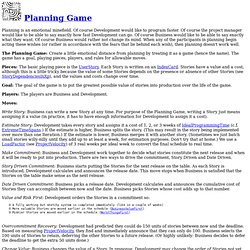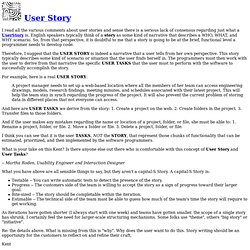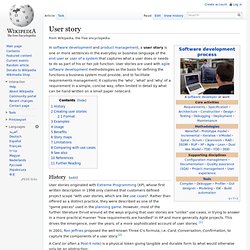

User Story Mapping. Story Mapping in a Nutshell. 20101007 how smart use cases drive web development. Release Plan. Planning Game. Planning is an emotional minefield.

Of course Development would like to program faster. Of course the project manager would like to be able to say exactly how fast Development can go. Of course Business would like to be able to say exactly what they want. Of course Business would rather not change its mind. When any of the participants in planning begin acting these wishes (or rather in accordance with the fears that lie behind each wish), then planning doesn't work well. 0 A fully working but sketchy system is completed immediately (like in a couple of weeks) 0 More valuable Stories are moved earlier in the schedule (BusinessValueFirst) 0 Riskier Stories are moved earlier in the schedule (WorstThingsFirst) Overcommitment Recovery: Development had predicted they could do 150 units of stories between now and the deadline.
A PlanningGame flow chart: (Web site gone. How do you reconcile the PlanningGame with the project that is re-writing an existing system, or systems? CategoryPlanning. User Story. I read all the various comments about user stories and sense there is a serious lack of consensus regarding just what a UserStory is.

English speakers typically think of a story as some kind of narrative that describes a WHO, WHAT, and WHY scenario. So, from that perspective, it is doubtful to me that a story is going to be at the brief, functional level a programmer needs to develop code. Therefore, I suggest that the USER STORY is indeed a narrative that a user tells from her own perspective. This story typically describes some kind of scenario or situation that the user finds herself in. A user story is to a use case as a gazelle is to a gazebo. My one liner is that a story is a promise to have a conversation and a use case is the record of the conversation. If you think you need one.
—JimStandley Very nice. —Alistair I hate to admit to being a star struck rube, but I got the chance to say that to Grady Booch and he smiled. “Because both begins with b.” -by Seannemo on 08/04/2008 at 1:20 PM Nice answer, SeanNemo! User Story And Use Case Comparison. Agile Requirements Writing. Building Better Software › Requirements 101: User Stories vs. Use Cases. Here’s a question that I get over and over again: What’s the difference between user stories and use cases?

— Ron K. Before I dive into an answer to that question, let’s rewind a little bit and talk about where user stories came from. I like them because they’re a great example of how the Agile movement changed the software world. Programmers used to just dive right into software projects and start coding. And that’s why I think the user story is one of the most useful tools to come out of the Agile movement. A use case is similar to a user story, because it also describes one specific interaction between the user and the software. Looking at those definitions, I can definitely see why there’s confusion about the difference between user stories and use cases. Use cases & UML. From Use case to User Story. Requirements capture and use cases - requirementsHO.pdf. User story. History[edit] User stories originated with Extreme Programming (XP), whose first written description in 1998 only claimed that customers defined project scope "with user stories, which are like use cases".

Rather than offered as a distinct practice, they were described as one of the "game pieces" used in the planning game. However, most of the further literature thrust around all the ways arguing that user stories are "unlike" use cases, in trying to answer in a more practical manner "how requirements are handled" in XP and more generally Agile projects. This drives the emergence, over the years, of a more sophisticated account of user stories. [1] In 2001, Ron Jeffries proposed the well-known Three C's formula, i.e. A Card (or often a Post-it note) is a physical token giving tangible and durable form to what would otherwise only be an abstraction; The Confirmation, the more formal the better, ensures that the objectives the conversation revolved around have been reached finally. Run tests.